[English] 日本語
 Yorodumi
Yorodumi- PDB-2k04: Structure of SDF1 in complex with the CXCR4 N-terminus containing... -
+ Open data
Open data
- Basic information
Basic information
| Entry | Database: PDB / ID: 2k04 | ||||||
|---|---|---|---|---|---|---|---|
| Title | Structure of SDF1 in complex with the CXCR4 N-terminus containing no sulfotyrosines | ||||||
 Components Components |
| ||||||
 Keywords Keywords | CYTOKINE / stromal cell derived factor-1 / SDF1-alpha / CXCL12 / CXCR4 / chemokine / locked dimer / Alternative splicing / Chemotaxis / Growth factor / Secreted / G-protein coupled receptor / Glycoprotein / Host-virus interaction / Membrane / Receptor / Sulfation / Transducer / Transmembrane | ||||||
| Function / homology |  Function and homology information Function and homology informationtelencephalon cell migration / chemokine (C-X-C motif) ligand 12 signaling pathway / C-X-C motif chemokine 12 receptor activity / response to ultrasound / negative regulation of leukocyte tethering or rolling / positive regulation of macrophage migration inhibitory factor signaling pathway / regulation of actin polymerization or depolymerization / chemokine receptor binding / Specification of primordial germ cells / CXCL12-activated CXCR4 signaling pathway ...telencephalon cell migration / chemokine (C-X-C motif) ligand 12 signaling pathway / C-X-C motif chemokine 12 receptor activity / response to ultrasound / negative regulation of leukocyte tethering or rolling / positive regulation of macrophage migration inhibitory factor signaling pathway / regulation of actin polymerization or depolymerization / chemokine receptor binding / Specification of primordial germ cells / CXCL12-activated CXCR4 signaling pathway / myosin light chain binding / myelin maintenance / CXCR chemokine receptor binding / C-X-C chemokine receptor activity / positive regulation of axon extension involved in axon guidance / positive regulation of vasculature development / positive regulation of dopamine secretion / Signaling by ROBO receptors / regulation of chemotaxis / induction of positive chemotaxis / Formation of definitive endoderm / integrin activation / negative regulation of dendritic cell apoptotic process / negative regulation of intrinsic apoptotic signaling pathway in response to DNA damage / C-C chemokine receptor activity / cellular response to chemokine / chemokine-mediated signaling pathway / Developmental Lineage of Pancreatic Acinar Cells / C-C chemokine binding / positive regulation of monocyte chemotaxis / chemokine activity / blood circulation / Chemokine receptors bind chemokines / anchoring junction / dendritic cell chemotaxis / positive regulation of calcium ion import / cellular response to cytokine stimulus / detection of temperature stimulus involved in sensory perception of pain / cell leading edge / positive regulation of oligodendrocyte differentiation / animal organ regeneration / Binding and entry of HIV virion / detection of mechanical stimulus involved in sensory perception of pain / positive regulation of T cell migration / regulation of cell adhesion / Nuclear signaling by ERBB4 / coreceptor activity / positive regulation of endothelial cell proliferation / neurogenesis / positive regulation of neuron differentiation / positive regulation of cell adhesion / axon guidance / ubiquitin binding / adult locomotory behavior / cell chemotaxis / growth factor activity / calcium-mediated signaling / defense response / brain development / response to peptide hormone / G protein-coupled receptor activity / response to virus / integrin binding / neuron migration / intracellular calcium ion homeostasis / chemotaxis / late endosome / : / positive regulation of cold-induced thermogenesis / positive regulation of cytosolic calcium ion concentration / virus receptor activity / actin binding / cytoplasmic vesicle / G alpha (i) signalling events / Estrogen-dependent gene expression / early endosome / response to hypoxia / lysosome / cell adhesion / immune response / positive regulation of cell migration / G protein-coupled receptor signaling pathway / inflammatory response / signaling receptor binding / external side of plasma membrane / apoptotic process / ubiquitin protein ligase binding / cell surface / signal transduction / protein-containing complex / extracellular exosome / extracellular region / plasma membrane / cytoplasm Similarity search - Function | ||||||
| Biological species |  Homo sapiens (human) Homo sapiens (human) | ||||||
| Method | SOLUTION NMR / AUTOMATED METHODS WERE USED FOR BACKBONE CHEMICAL SHIFT ASSIGNMENT, ITERATIVE NOE REFINEMENT. FINAL STRUCTURES WERE OBTAINED BY MOLECULAR DYNAMICS IN EXPLICIT SOLVENT. | ||||||
 Authors Authors | Volkman, B.F. / Veldkamp, C.T. / Peterson, F.C. | ||||||
 Citation Citation |  Journal: Sci.Signal. / Year: 2008 Journal: Sci.Signal. / Year: 2008Title: Structural basis of CXCR4 sulfotyrosine recognition by the chemokine SDF-1/CXCL12 Authors: Veldkamp, C.T. / Seibert, C. / Peterson, F.C. / De la Cruz, N.B. / Haugner, J.C. / Basnet, H. / Sakmar, T.P. / Volkman, B.F. | ||||||
| History |
|
- Structure visualization
Structure visualization
| Structure viewer | Molecule:  Molmil Molmil Jmol/JSmol Jmol/JSmol |
|---|
- Downloads & links
Downloads & links
- Download
Download
| PDBx/mmCIF format |  2k04.cif.gz 2k04.cif.gz | 1.4 MB | Display |  PDBx/mmCIF format PDBx/mmCIF format |
|---|---|---|---|---|
| PDB format |  pdb2k04.ent.gz pdb2k04.ent.gz | 1.2 MB | Display |  PDB format PDB format |
| PDBx/mmJSON format |  2k04.json.gz 2k04.json.gz | Tree view |  PDBx/mmJSON format PDBx/mmJSON format | |
| Others |  Other downloads Other downloads |
-Validation report
| Summary document |  2k04_validation.pdf.gz 2k04_validation.pdf.gz | 512.6 KB | Display |  wwPDB validaton report wwPDB validaton report |
|---|---|---|---|---|
| Full document |  2k04_full_validation.pdf.gz 2k04_full_validation.pdf.gz | 1.2 MB | Display | |
| Data in XML |  2k04_validation.xml.gz 2k04_validation.xml.gz | 114.3 KB | Display | |
| Data in CIF |  2k04_validation.cif.gz 2k04_validation.cif.gz | 148.3 KB | Display | |
| Arichive directory |  https://data.pdbj.org/pub/pdb/validation_reports/k0/2k04 https://data.pdbj.org/pub/pdb/validation_reports/k0/2k04 ftp://data.pdbj.org/pub/pdb/validation_reports/k0/2k04 ftp://data.pdbj.org/pub/pdb/validation_reports/k0/2k04 | HTTPS FTP |
-Related structure data
| Related structure data | 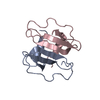 2k01C  2k03C 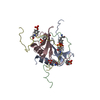 2k05C C: citing same article ( |
|---|---|
| Similar structure data | |
| Other databases |
- Links
Links
- Assembly
Assembly
| Deposited unit | 
| |||||||||
|---|---|---|---|---|---|---|---|---|---|---|
| 1 |
| |||||||||
| NMR ensembles |
|
- Components
Components
| #1: Protein | Mass: 8188.760 Da / Num. of mol.: 2 / Fragment: SDF-1-alpha(3-67) domain / Mutation: L36C,A65C Source method: isolated from a genetically manipulated source Source: (gene. exp.)  Homo sapiens (human) / Gene: CXCL12, SDF1, SDF1A, SDF1B / Production host: Homo sapiens (human) / Gene: CXCL12, SDF1, SDF1A, SDF1B / Production host:  #2: Protein/peptide | Mass: 4518.772 Da / Num. of mol.: 2 / Fragment: N-terminus, residues 1-38 / Mutation: C28A Source method: isolated from a genetically manipulated source Source: (gene. exp.)  Homo sapiens (human) / Gene: CXCR4 / Production host: Homo sapiens (human) / Gene: CXCR4 / Production host:  Has protein modification | Y | |
|---|
-Experimental details
-Experiment
| Experiment | Method: SOLUTION NMR | ||||||||||||||||||||||||||||||||||||
|---|---|---|---|---|---|---|---|---|---|---|---|---|---|---|---|---|---|---|---|---|---|---|---|---|---|---|---|---|---|---|---|---|---|---|---|---|---|
| NMR experiment |
|
- Sample preparation
Sample preparation
| Details |
| ||||||||||||||||||||
|---|---|---|---|---|---|---|---|---|---|---|---|---|---|---|---|---|---|---|---|---|---|
| Sample |
| ||||||||||||||||||||
| Sample conditions | Ionic strength: 21 / pH: 6.8 / Pressure: AMBIENT / Temperature: 308 K |
-NMR measurement
| NMR spectrometer | Type: Bruker Avance / Manufacturer: Bruker / Model: AVANCE / Field strength: 600 MHz |
|---|
- Processing
Processing
| NMR software |
| ||||||||||||||||||||||||||||||||
|---|---|---|---|---|---|---|---|---|---|---|---|---|---|---|---|---|---|---|---|---|---|---|---|---|---|---|---|---|---|---|---|---|---|
| Refinement | Method: AUTOMATED METHODS WERE USED FOR BACKBONE CHEMICAL SHIFT ASSIGNMENT, ITERATIVE NOE REFINEMENT. FINAL STRUCTURES WERE OBTAINED BY MOLECULAR DYNAMICS IN EXPLICIT SOLVENT. Software ordinal: 1 Details: CXCL12/CXCR4 COMPLEX STRUCTURES ARE BASED ON A TOTAL OF 2012 NOE CONSTRAINTS ( 744 INTRA, 384 SEQUENTIAL, 238 MEDIUM, 444 LONG RANGE, 110 CXCL12 INTERMONOMER CONSTRAINTS (CXCL12 TO CXCL12), ...Details: CXCL12/CXCR4 COMPLEX STRUCTURES ARE BASED ON A TOTAL OF 2012 NOE CONSTRAINTS ( 744 INTRA, 384 SEQUENTIAL, 238 MEDIUM, 444 LONG RANGE, 110 CXCL12 INTERMONOMER CONSTRAINTS (CXCL12 TO CXCL12), AND 92 INTERMOLECULAR CONSTRAINTS (CXCL12 TO CXCR4)) AND 128 PHI AND PSI DIHEDRAL ANGLE CONSTRAINTS. CONSTRAINT WERE IN ONE ASSIGNED AND VALIDATED IN ONE CXCL12/CXCR4 COMPLEX AND THEN DUPLICATED TO GENERATE A SYMMETRY RELATED CONSTRAINT IN THE SECOND COMPLEX. CONSTRAINT TOTALS LISTED ABOVE INCLUDE CONSTRAINTS FROM BOTH MONOMERS. | ||||||||||||||||||||||||||||||||
| NMR representative | Selection criteria: lowest energy | ||||||||||||||||||||||||||||||||
| NMR ensemble | Conformer selection criteria: target function / Conformers calculated total number: 100 / Conformers submitted total number: 20 |
 Movie
Movie Controller
Controller


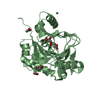

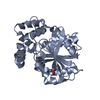
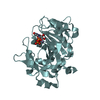

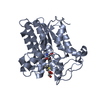

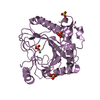
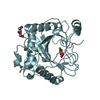
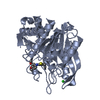
 PDBj
PDBj












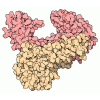
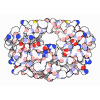


 Xplor-NIH
Xplor-NIH